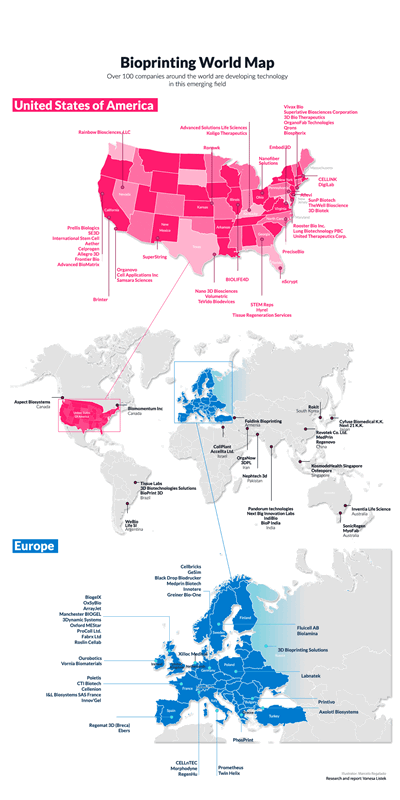Introduction: Since 3DPrint.com created the Bioprint section in June 2019 and published its first 'Bioprinting Company World Map', the bioprinting market has arguably undergone a 'sea change'. With the economic impact of the Covid-19 epidemic, many companies have been bought out, renamed or even moved to another country, so it's time to reorganise the new 'Bio 3D Printing Map'!
Bio-3D printingcompanies
Bioprinting is closely linked to the groundbreaking research being done by academics, institutions and the medical community. A decade ago, only a handful of companies began commercialising bioprinting technology; Organovo was a pioneer in this field, having been founded in 2007 at the time of commercialising tissue patches for the treatment of liver disease. Around the same time, other bio-3D printing companies were emerging, such as Switzerland-based regenHU, which launched a new product by 2020 but ran into operational problems. other bioprinting frontrunners such as DigiLab and CELLINK have changed their names to Cellular Life Sciences and BICO ( STO: BICO ), but have remained at the forefront of the bioprinting industry, creating some of the most popular printing machines on the market.
Of these, BICO has seen better growth. 2021 saw it grow net sales by over 600% following its rebranding, driven by a boom in acquisitions and its own growth. The strategy of acquiring technology to cover the entire bioprinting workflow began in 2018, when BICO acquired Dispendix, a German supplier of automated liquid handling instruments. since then, the company has acquired 12 other startups, including Allegro 3D. while BICO's business seems to be perfect, the company's business is still in the hands of one of its co-founders and chief financial officer ( CFO), Gusten Danielsson. However, after the departure of one of the company's co-founders and chief financial officer (CFO), Gusten Danielsson, some internal struggles began to emerge, which affected the printing market to some extent.
3D Systems
One of the most strategic moves in the sector came from 3D Systems (NYSE: DDD). While the company's strength is its portfolio of industrial additive manufacturing solutions for plastic and metal parts, it is now venturing further into bioprinting. Over the past few years, the massive demand for bioprinting and regenerative medicine has prompted AM pioneer and 3D Systems co-founder Chuck Hull to create a bioprinting division within the company. After successful collaborations with biotech companies United Therapeutics Corporation and Lung Biotechnology PBC, the two companies expanded their partnership. in June 2022, they presented a complete 3D printed lung scaffold at Life Itself, sponsored by CNN. Arguably one of the most complex objects ever made in the field of bio-3D printing, the two companies are now already developing two other organs, the kidney and the liver.

△ 3D printed lung scaffold. Image courtesy of 3D Systems.
The latest map of the world of bio-3D printing

In 2019, the report noted that the US is the dominant force in biometric 3D printing, with 39% of companies based in 18 US states. Today, the US remains the leader in bioprinting, with 40% of companies located in 16 US states. In addition, Canada is home to the top three bioprinting companies, making North America the leading region for emerging bioprinting companies.
Continental Europe follows with 38% of the total number of companies (35% in 2019), followed by Asia with 17% (a figure that has remained stable since 2019), Latin America with only three companies and Australia (representing Oceania) with only one. As in 2019, countries such as the UK, Germany and France account for the majority of business. China remains the region where Asian 3D printing companies are located, with four companies. In addition to China, there are now relevant start-ups working on bioprinting hardware, software and materials in India, Iran and Israel.
Some countries have lost many bioprinting companies since 2019, such as Italy, Australia and Ireland, with the collapse of at least two start-ups in each country. For example, in Ireland both Ourobotics and Vornia Biomaterials collapsed, so there are now no bioprinting companies in Ireland. Similarly, Italy used to have three bio-3D printing companies, but now has only one. Today, Australia is one of the most innovative countries for bioprinting research (mainly in universities and hospitals), but it has only one bioprinting startup, Inventia Life Sciences.
However much the landscape of the bioprinting industry changes, new players will continue to emerge. Although the ultimate goal of bioprinting organs for human transplantation is still a long way off (experts estimate that it will be 15 to 20 years before clinical trials see the light of day), Mohou.com believes that the continued development of biometric 3D printing technology will eventually benefit humanity.



